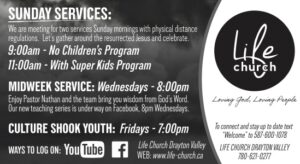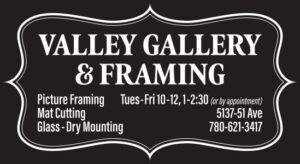When winter weather strikes people rely on their tax dollars to go to work clearing those roads and making them safe.
Adam Saltesz, the assistant director of Public Works for Brazeau County, says when a big snowfall comes, crews are on the roads at 6 a.m. working on clearing them. They work until 6 p.m. each night and go for seven days a week.
“They’re out on the roads before most of us even get out of bed in the morning, which is pretty impressive,” says Saltesz.
Dr. Chris Birchall Dentistry
Share on facebook Facebook Share on email Email Share on linkedin LinkedIn Share on whatsapp

Drayton Valley Insurance
Share on facebook Facebook Share on email Email Share on linkedin LinkedIn Share on whatsapp

Ralcomm Communications
The Ralcomm Group provides communication devices for individuals and businesses. We specialize in technology that

B.D. Lock and Key Ltd.
Share on facebook Facebook Share on email Email Share on linkedin LinkedIn Share on whatsapp
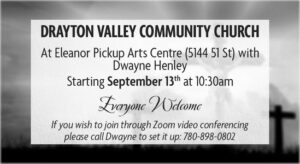
He says the recent snowfalls have been particularly difficult for the County to work on. “The freezing rain event we recently experienced caused our roadways to become quite icy, and when compounded with the extended periods of extreme cold, winter maintenance activities became much more difficult. These low temperatures we have seen recently are not only hard on the equipment, they also decrease the effectiveness of the salt used for roadway de-icing purposes. In the de-icing world, the practical working temperature of salt is generally considered to be above -15°C. Below -15°C, the ice melting speed of salt becomes impractically slow and ineffective.”
He says the first priority is the paved roadways, which they try to keep as close to bare as possible.
“We try to get them cleared within eight hours of the snow event,” he says. They try to get to the paved roadways quickly to prevent snow and ice from getting packed down by people travelling to work.
Members of local indigenous groups are working toward opening a charter school with the goal of offering students an education that goes beyond academics.
Charlene Bearhead, a member of the board for the Roots of Resilience not-for-profit society, says the group is applying to the Minister of Education to be able to open a charter school in Drayton Valley, with a goal of opening in September.
The society is hosting an information night on February 13 from 5-7:30 p.m. at the Holiday Inn Express.
Bearhead says her 40 years of working in education has made it clear that the system is failing children and staff as human beings.
“I’m always a big believer in doing the best you can to try to work with what exists already and do what you can to help guide that,” says Bearhead.
She worked within the system, and recently served as a school board trustee, but she says people weren’t ready to progress with changes she feels need to be made.
The goal of opening the charter school is to offer a learning experience that encompasses a child’s entire wellbeing, including mental and spiritual health, along with teaching Alberta’s curriculum. While the students will learn from methods that indigenous people have always used for passing on knowledge, Bearhead says the school isn’t just open to indigenous children. Any child in the area from Kindergarten to grade 12 will be welcome to attend.
One thing that Bearhead wants the public to be aware of regarding charter schools is that they are still public schools. Roots of Resilience will be funded in the same manner that Wild Rose School Division and the St. Thomas Aquinas Roman Catholic School Division are.
“One lady said to me, ‘This sounds so amazing Charlene, but I really struggle with anything that takes away from public schools,’” says Bearhead. “I had to say to her ‘This is public education. This is public school.’”
She says there are only provisions for charter schools in Alberta. Charter schools receive the same funding for facilities, transportations, and other expenses, and the same requirements to follow the Alberta curriculum and the Education Act. Just like any other public school, parents do not have to pay extra to enrol their children in a charter school.
“But they are intended to be schools of choice,” says Bearhead. “They give parents and kids a choice in their education.”
However, charter schools are not without controversy. According to the website of Alberta Teachers’ Association, “there is only one pot of money for schools in Alberta. When money is diverted to private and charter schools, it leaves public schools in a funding shortfall.”
Bearhead says charter schools have to offer a unique approach to education that isn’t available in the geographic area. Bearhead says it’s important to the RoR society to define the holistic success for the school, which means the students will be doing better in body, mind, and soul, as well as academically.
She says that pushing people hard to do well academically while ignoring all other aspects of the student’s progress doesn’t work well. For Bearhead, it’s important for educators to meet the students where they’re at, value them as human beings, offer them a safe environment, and offer opportunities for the students to see themselves reflected in what is being taught.
Along with the regular curriculum, Bearhead says they plan to offer language programs for those who are interested in learning the language of their ancestors to help those students connect with their heritage.
Wendy Snow, the Interim District Captain in the Otipemisiwak Metis Government for District Eight and member of the RoR society, says she feels her own children would have benefitted from what the proposed school will be offering.
Snow says she has two children as well as a niece that she is the guardian of. With all three of them going to school in Drayton, she says they went to almost every school in the community.
“I found that it was very lacking as far as teaching to our culture,” says Snow.
She says every year she would fill out the demographic forms, indicating that her children were indigenous, knowing that the school division would get additional funding for those students.
“I found that all of the funding in the Wild Rose School Division went to Rocky Mountain House,” she says. “All the programming, all the culture stuff, everything went to Rocky Mountain House.”
Like Bearhead, Snow wanted to work with the system and try to help improve things. She ran twice for school board trustee, but did not get elected.
“I’ve always wanted to see more funding and programming and culture stuff in this area, just like there is in Rocky Mountain House,” says Snow.
Bearhead says the RoR school will resonate with indigenous children.
“An indigenous pedagogy, or approach to education, is about physical, mental, social, emotional, and spiritual [well-being]. Whatever that means to you. Everyone is indigenous to somewhere,” says Bearhead.
She says public charter schools are smaller and have unique approaches to education.
“They are actually intended to be models for how education could happen in any or all public schools,” she says.
Bearhead says when the students see themselves reflected in the content they’re learning, they have a better chance of relating to it and absorbing it.
By making the students the centre of the system, educators can focus on the whole child, not just the content they’re supposed to be learning. She says each student has different strengths, weaknesses, interests, and paths. In their school, they plan to help students excel at their strengths, offer support for their weaknesses, and encourage their interests and plans.
Another important part of education is offering the students a safe space.
“If kids are terrified, if kids are being bullied, if kids don’t feel safe, how can they focus on learning?” says Bearhead. “That’s just human instinct. That’s survival.”
She says if students are feeling ostracized, alienated, or left out, it’s more challenging for them to learn.
Roots of Resilience will also offer hands-on learning for students. This experiential learning will be land-based, which means there will be more of a balance between indoor and outdoor learning. She says there are many different areas of the curriculum that can be taught outdoors beyond science and physical education.
“For me, when you do something, rather than just read about it or hear about it, it becomes ingrained in you,” she says.
Snow says she wants to see children in the area have an opportunity to choose an education that best suits them.
“I think it just gives them a great basis for success later on in life,” says Snow.
Learning About the Newspaper
Grade 4: Let's learn about the Newspaper
What is a newspaper?
A newspaper is a collection of stories, photos, advertisements, columns and letters that represent the collective news and mood of your community at a given point in time.
Types of Newspaper
National Newspapers: National Post, Globe and Mail
Provincial Newspapers: Edmonton Journals, Calgary Harold
Regional/Local Newspapers: That Us! Often locally owned, family started and some are 60-100 years old.
Other Regional:
Activity 1: Get to know the newspaper
Activity: Seek and Find
What you need: 1 piece of paper, 1 pencil, 1 Free Press Newspaper
- Get into teams of 4
- On a piece of paper write down numbers 1-5
- Find these 5 things in the paper
- Bring your answers up to me and shake the bottle when you’re done
- Fastest team gets a prize
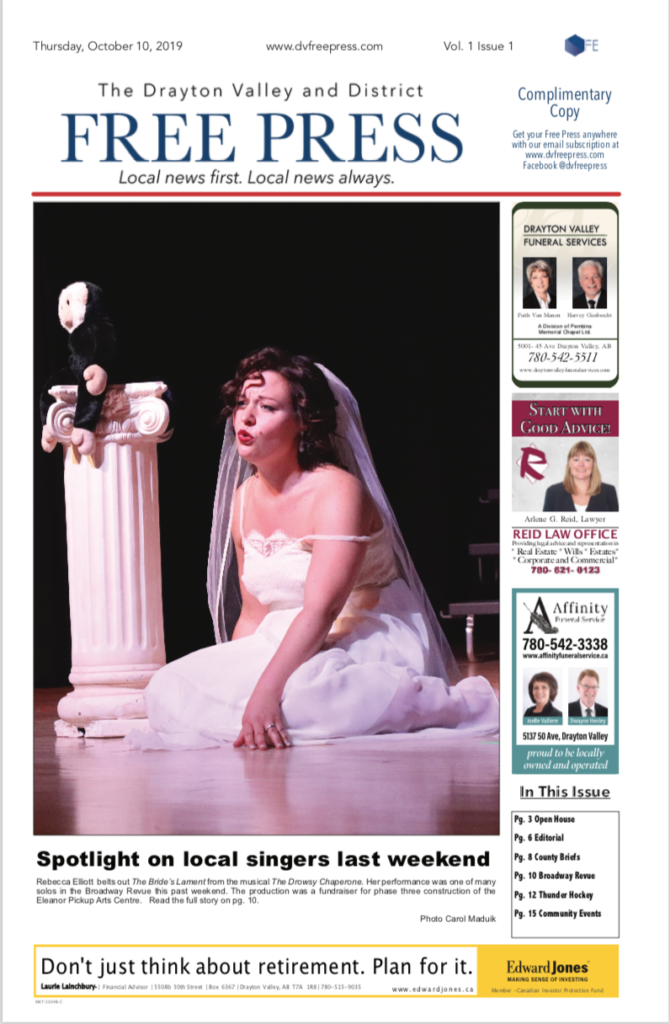
And Go....
- What is the tagline under the “Free Press” masthead on pg. 1?
- Who wrote the letter about the ski hill?
- Who took the photo on pg. 11?
- Name one business in the business directory?
- Who is the editor of newspaper (name): _____________
Getting in front of eyeballs: How is the newspaper distributed?
Making sure the newspaper is seen is a big part of having a local newspaper. Distribution channels helps to make this happen. The Free Press has 3 distribution channels.
1. Email Subscriptions
2. Canada Post mail subscriptions
3. Free pickup in retail locations
Fact Checking and Credtiability
“Thou shalt not lie.” Why do you think it is important not to lie?
Creditability is the foundation of any newspaper. If your readers cannot trust what you are writing you won’t have an audience for long. This is why our editor spend much of his time fact checking, and rechecking facts in the stories we publish.
Activity 2: Examine a story
Read: “Councillor Responds to Allegations”
What are some facts in this story that needed to be checked?
Activity 3: Telephone fact checking
- Get into 2 long lines
- Teacher select 2 people to be “fact checkers”
- Beginning at the start whisper message into your neighbours ear, and continue down the line.
- Once the message gets to a fact checker, the fact checker will give a thumbs up to continue telephone if the message is correct or go back to the start of the line to restart the telephone if the message is incorrect.
Here are some sources we use to check facts:
Call people to confirm information
Voice record interviews
Use multiple sources
Discussion: What ways can you check the facts for school projects?
Jobs at a newspaper
Running a newspaper requires a team. Each person contributes to the success of the paper. Below are some jobs that people have to making a successful local newspaper.



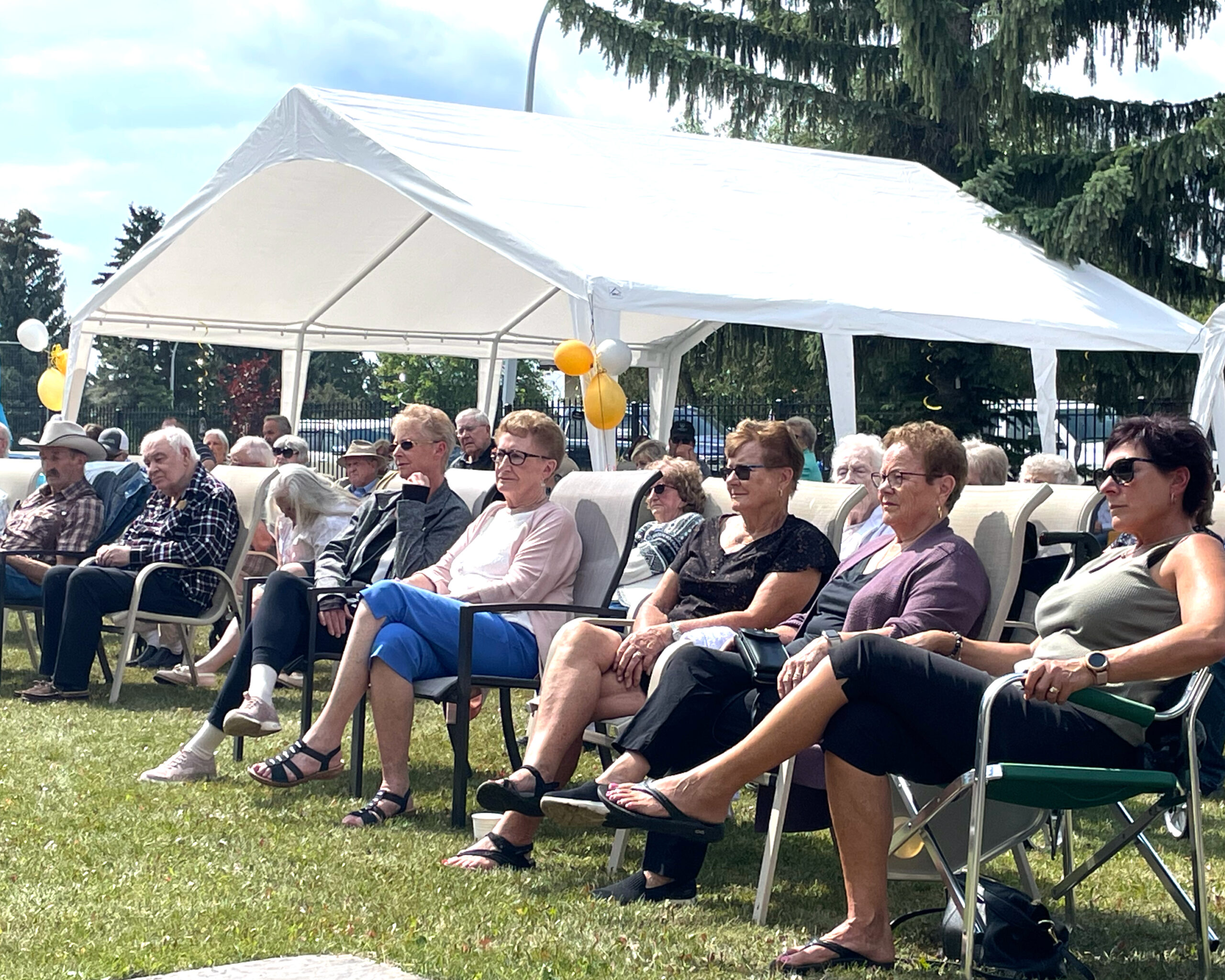




Activity 4: Who does what?
In groups of 4 go to PAGE 1 and PAGE 9 of the newspaper and label who did what.
E = Editor
R = Reporter
GD = Graphic Designer
C = Columnist
S = Sales
Activity 5: Conducting an Interview Speed Style
Interviewing people is a major job of a newspaper reporter. To conduct a good interview you need these three elements:
1. Questions; open ended
2. Paper and pen, or recorder
3. Listening ears and eyes
Open Ended Questions
Open ended questions are questions that get people talking. The are not yes or no questions. They are “How,” “Who,” and “What” questions.
Example: How did you feel winning the basketball game? What inspired you to write that story?
Never go to a newspaper interview without a recording device; Paper, pen, voice recorder or texting device. Reporters often quote and paraphrase their subjects and accuracy is key.
Quote: “I love to teach,” Kormysh said.
Paraphrase: Kormysh said she loves teahing.
Recording Tool
Active listening
Active listening means you are listening with your ears (close your mouth), your eyes and your body language. The key to a good interview is to get the other person talking this means you have to stop talking.
Speed Interview Game
- Take out a piece of paper.
2. Write down 1 open ended question you can ask your classmates
3. Break out in to two lines
4. When I say go, line A is going to ask classmates your question and record the answer.
5. Line A takes A step to the Right, and Line B asks their classmates their question.
6. Record their answers.
7. Discussion: How was your experience? How accurate did you record?
Final Activity 6: Photo and Feedback
Take the handout and answer the following question.
A. What is one thing I learned about the newspaper?
B. Gather for a Group Photo
Mental health calls drain resources
Police in Drayton Valley have seen an increase in the last year of arrests made under the Mental Health Act. Earlier this month Staff Sergeant Ryan Hoetmer told town council that calls of that type have seen a steady increase over the past several years, and they remain a big drain on resources for the Town.
Hoetmer explained that when the officers take somebody into custody under the act, they then take that person to the Centennial Centre for Mental Health in Ponoka. He says the drive itself eats up several hours of the officer’s time, but they also have to wait until staff at the centre take over.
He said the Centennial Centre has been working to make the intake process more efficient. In the past, officers have had to wait a couple of hours. Now, he says they make a call when they are on their way, and usually the intake is complete within half an hour.
When asked how long people are kept at the hospital, Hoetmer explained that they were normally kept for a week or two. At most, he believes they might be kept for a month.
Many of their calls under the Mental Health Act are from people the RCMP are already aware of, and Hoetmer says it can be a challenge keeping on top of those cases.
He says the RCMP bring the subject into the hospital. Once they are deemed healthy enough to depart, the person is often sent back to their community in a cab. After that, the individuals are in the same position they were in prior to the process beginning.
“I’m a big believer that there’s a bit of a gap there,” said Hoetmer. “When they are sent in a cab back to Drayton, they’re put back into the same position as before. There is no follow up program or some place for them to go in between.”
He said often RCMP watch the individuals as their mental health slowly declines until they have the grounds to apprehend them again.
Councillor Amila Gammana asked Hoetmer if he felt the reason people were being released on such a short timeline was due to a lack of resources. Hoetmer said he wasn’t sure what the reason for it was and that Alberta Health Services would better be able to answer that.
“I would hope it’s not a resourcing concern, that when the doctor is making their determination they are healthy enough to leave the facility,” he said. “But they have pressures, I’m sure, just like everybody else.”
Mayor Nancy Dodds asked Hoetmer if he’d seen an increase in resources since the new pillar ministries had been put into place, but Hoetmer says thus far they haven’t seen a change.
“We still have our one [Regional Police and Crisis Team] that operates out of Rocky, but as I’ve talked about before they are in our community maybe once a week,” said Hoetmer.
This means if there is an emergent issue that requires a response, the RPACT are not the ones who are responding to the call. It is instead left to the members of the Drayton Valley detachment.
“They do lots of follow up for us, but it’s our members that are doing the apprehensions and are going to the crisis when it’s happening,” said Hoetmer.
Support group for new Canadians
Moving to a new place can be stressful even if you are only moving one town over, but if you’re coming in from a different country, it can be overwhelming.
Verna Wicks, with Drayton Valley Community Learning (DVCL), is working together with other organizations in the community to build a Newcomers Support Team. The group is geared toward connecting people moving to the town or county with services they will need to get established.
What might feel like common sense to many people is not so easy for New Canadians. If they aren’t fluent in English or don’t know anyone in the area, setting up basics, like bank accounts and getting set up with Alberta Health Care could seem nearly impossible.
Wicks says interested parties decided to offer those supports early in 2024, but it wasn’t until DVCL received some grant funding last fall that they were able to hire someone for the group.
She says there are a number of groups who have been involved in setting up the team, including Family and Community Support Services, Alberta Health Services, the Multicultural Association, the library, the Town, the Chamber of Commerce, the Alberta Government, and many members of the public.
Similar to the Youth Hub, the support team is aiming to be a one stop connection point for newcomers. Wicks says the goal is to open a welcome centre that they can be directed to. At the centre, the newcomers will be connected with people and services in the community to help get them settled in.
Along with information and support, Wicks says they hope to also be able to give out a care package.
“We’re hoping that we’ll have some supplies for them if they need clothing or things for babies,” says Wicks.
The team would also like to host social events to help them meet new people. Last fall, they held their first welcoming event.
“That was open to newcomers and people from the community who wanted to welcome them,” she says.
Right now, the team is looking around the area to see which services are already being offered. Then, if they find any gaps, they can step up and provide something to meet those needs.
They are also putting together a document that can be given to immigrants in the community. She says it will contain a lot of basic information including contacts for different religious groups, and contacts for community and emergency services.
Wicks says there’s also a balance that the team needs to find. Right now there are many newcomers coming to the community. Some are refugees, some are looking for work, and others are coming through programs like the Rural Renewal Stream. However, the amount of newcomers may not always be so high.
She says there are also concerns about steady government funding. Recently, the federal government announced they would be cutting back on funding for support services for new immigrants. While the brunt of that will likely be felt in larger centres, Wicks says it’s making them cautious about asking for funds from any level of government.
The grant the team received in 2024 was renewed for 2025, but they won’t know for sure if it’s renewed for 2026 late 2025 or early 2026.
Anyone looking for more information about the team or the support they provide can reach out to Wicks at settlementservices@dvcommunitylearning.ca.
Bus association reaches end of the road
All good things must come to an end. The Drayton Valley Community Bus Association, which has been a fixture in the area since the 1970s, has ceased operations.
In an interview with the Free Press last week, Wendell Smith, the association’s treasurer, said a number of factors played a part in the decision to close effective December 21 last year. The majority of those factors revolved around increasing expenses and declining ridership.
“Diesel fuel is higher, insurance is higher. People don’t want to pay,” he said.
The bus association has played an important part in the growth of Drayton Valley. It was incorporated in May of 1973 by local business owners who were concerned about highway safety and who wanted to contribute something positive to the community.
“They bought a bus and founded the bus association and it’s been running ever since,” said Smith.
Over the last half century the bus association has covered hundreds of thousands of kilometres taking local residents to events across this part of Alberta and further afield. Many of those journeys were on school field trips or for minor hockey or other sports. Smith, who has been driving since 2001, said he’s happy to have played a part in the lives of so many local residents and is proud of the association’s record for getting people where they needed to be.
“We drove the Thunder for 25 years,” he said. “In all those years we were never late for an out of town game.”
Smith says at one point the association operated as many as “six or seven” buses. However, changing times have seen increasing numbers of potential riders using their own vehicles to attend out of town events. In recent years the number of buses operated by the association decreased to three; a 58 passenger coach, a 21 passenger mini bus and a 44 passenger school bus. Declining demand for busing means that those vehicles will now be put up for sale.
“The economy is hurting everybody,” he said. “If the economy isn’t booming people don’t have the money to hire a bus. I can’t blame any business for not using the service … The money’s just not there.”
Town responds to business concerns
After concerns raised at a pair of public meetings late last year, interim CAO for Drayton Valley, Pat Vincent, demonstrated the Town’s commitment to businesses and residents by presenting council with a detailed report that spoke to a range of issues at the last Governance and Priorities meeting.
Erik Bergen, a local business owner, came forward on November 20 with a presentation he had put together after having two open meetings with businesses in the community earlier in the fall. In his presentation, Bergen highlighted three main areas of concern: the homeless population, Town services and communications, and the free enterprise market in the community.
Bergen outlined several of those concerns as well as possible solutions for council to consider.
In the report Vincent brought forward, there were five separate responses from management involved in the areas that the businesses had issue with.
Enforcement services touched on several areas brought forth by Bergen. This included listing the various bylaws and acts that already addressed many of the areas of concern with the homeless population. The Community Standards Bylaw, the Municipal Government Act, and provincial trespassing legislation combined cover sleeping in public places, public disruption, loitering, public urination and defecation, unauthorized encampments, open fire, storage of personal items, and dumpster diving.
Cody Rossing, the manager of enforcement services and emergency management, also outlined areas that the Town could consider to help bolster the current laws surrounding those issues, such as amendments to the Outdoor Restrictions Burning bylaw and some possible amendments to the Community Standards Bylaw.
Rossing also explained that Drayton Valley could not create its own lower level court system to deal with petty crimes. However, he did say the community could petition for more court dates in Drayton Valley, which would allow more time for the courts to deal with all matters.
“Currently, with the scheduling at the Drayton Valley Court of Justice, trial dates are occurring on the same days for criminal code matters, provincial matters and municipal bylaw matters,” he says in his report. “This often results in lower-level offences either being withdrawn, or deals made to have the lower-level items removed so time can be focused on criminal code matters.”
As far as public safety in regards to needles, Rossing says they received only one call in 2023 from a business owner. In the past six months the Town’s Occupational Health and Safety Department only had four reports of Town staff locating needles.
Lola Strand, the manager of community services for the Town, spoke to the number of homeless individuals in the community and the efforts made to address the issue.
She mentioned the 2023 study done by the Rural Development Network, that found there were more than 8,300 individuals in rural Alberta dealing with some sort of housing issue. In Drayton, there were 28 people without homes, 25 people accessing emergency shelters such as the shelter pods or warming hearts, 83 people who were provisionally accommodated through things like couch surfing, and 140 individuals who were at risk of homelessness due to precarious housing.
Strand spoke to the strain enforcement services were dealing with in regard to responding to complaints of unsheltered people. She says the Town received a grant to hire a Community Outreach Worker who is communicating with at-risk individuals to help connect them to resources.
She also pointed out that along with the temporary emergency shelters the Town has put into place, there are also 26 affordable housing units in the community. Humans Helping Humans, the local organization that currently runs the shelter pods, has also built nine homes with grants, donations, and volunteers that have helped 19 families move into the regular housing market.
Strand also suggested the Town could work with the province to build halfway houses, or using grant money to purchase seacans, or trailers that can provide shelters in the encampment around the landfill that many of the homeless population are currently using.
Jenn Stone with intergovernmental relations and communication for the Town, outlined the different ways that the Town communicates with its residents.
The Town has a threefold approach to communication: traditional media, social media, and direct communication.
With advertisements and news stories, the Town works with the Drayton Valley Free Press and Big West Country 92.9. They also have pages on social media, the Town’s website, and YouTube. The electronic sign located at 50 Street and 50 Avenue is also used for communications. On top of those methods, the Town has held open houses, public hearings, direct mail, and door-to-door notices.
By using these different options, the Town is providing several different methods of communication for all age demographics.
Public works also responded to the grievances in the report, specifically in regard to the insect population, weed control, and snow removal.
When it comes to pesticides and herbicides, the individual applying the substances has to be certified and trained in the use of the chemicals. If at any point the Town doesn’t have many employees that meet those criteria, it can be difficult for them to keep up with the applications.
When it comes to insects, the Town only sprays for stinging insects in public spaces. They work to stay on top of the issues and will follow up to check on activity. They also use the public portal the Town provides through their website, to learn about any issues that residents have raised a concern with.
Spraying for weeds also has its challenges. There are limited time frames in which the application will be effective, such as when the weeds are actively growing. Then they also have to work around the weather, as it won’t be as effective if it’s raining. If those two requirements are met, the Town also has to consider any events going on and provide notices to nearby businesses and residents before they begin spraying.
For snow removal on sidewalks, the Town currently clears 53.4 km of asphalt trails and sidewalks in the community. Prior to 2022, the Town was clearing sidewalks in the downtown core, however, an amendment to the snow removal policy in November 2022 removed the downtown core from areas to be cleared.
Public works says if they were to be responsible for removing snow from all sidewalks in the community, they would have to double their staff and equipment to keep up with it. They say it is a common issue with many municipalities and one that is becoming more and more challenging.
The report also addressed the business owners’ concerns surrounding a free market in the community.
Peter Vana, the interim general manager for planning and growth development in the community, says there are legal limits to what the Town can do in regards to limiting businesses.
Vana says the Municipal Government Act grants municipalities the power to regulate businesses, but not prohibit businesses. Vana provided examples of land use regulations in several communities to show the different ways that the issue can be approached.
Along with that, Vana made some suggestions that might help to alleviate the issue, such as making restaurants a discretionary use in all districts, providing varying business license fees, partnering with local businesses to help give them better strategies to succeed.
However, Vana also pointed out some issues with picking a particular sector to regulate. He says were the Town to put in regulations on franchises in the food industry, it should be applied to all industries across the board, including oil and gas, as well as retail, as companies like Walmart or Canadian Tire could be seen as a threat to local businesses.
Vana also mentions that many franchises are owned by local residents, so they are in many ways, just like other local businesses.
Other problems with restricting franchises that Vana brought forward included that the public would like to have competition as it offers options and keeps prices lower. He also pointed out, using pizza restaurants as an example, that there are eight restaurants that mainly sell pizza, nine other restaurants that sell pizza as a sideline, and two other businesses that occasionally sell pizza as well.
Vana questions whether or not the Town would have to be completely aware of the different items each restaurant sells when deciding whether a business should be allowed or not.
Council accepted the report as information after asking several questions of the departments. Vincent says he made the businesses aware the report was being discussed at the meeting, but there were no representatives for council to ask questions of.
However, he says it’s important to note that Brazeau County is not responsible for any of the numbered highways in their area. Those highways, such as 22, 39, 620, 621, or any other numbered highway, are under the jurisdiction of the Alberta Government. Saltesz says the government has a contractor in the area that they hire to do those roadways.
After the paved roads are done they focus on the graveled roads. Saltesz says typically they leave 10 cm of packed snow on the gravel roads before they worry about them. “But in heavy snowfall events like we’ve had [recently] we’re out there, regardless, pushing snow around.”
Once the gravel roads have been looked after they switch over to clearing the hamlets, public sidewalks, and private driveways. “That’s normally our third priority,” says Saltesz. They also have 20 employees who monitor the weather, organize the response, and do other planning around the whims of Mother Nature to ensure the roads are safe.
During smaller snowfall events, he says they try to take care of the driveways and the approaches at the same time. However, when there is a big event, they don’t have time to do that.
Members of local indigenous groups are working toward opening a charter school with the goal of offering students an education that goes beyond academics.
Charlene Bearhead, a member of the board for the Roots of Resilience not-for-profit society, says the group is applying to the Minister of Education to be able to open a charter school in Drayton Valley, with a goal of opening in September.
The society is hosting an information night on February 13 from 5-7:30 p.m. at the Holiday Inn Express.
Bearhead says her 40 years of working in education has made it clear that the system is failing children and staff as human beings.
“I’m always a big believer in doing the best you can to try to work with what exists already and do what you can to help guide that,” says Bearhead.
She worked within the system, and recently served as a school board trustee, but she says people weren’t ready to progress with changes she feels need to be made.
The goal of opening the charter school is to offer a learning experience that encompasses a child’s entire wellbeing, including mental and spiritual health, along with teaching Alberta’s curriculum. While the students will learn from methods that indigenous people have always used for passing on knowledge, Bearhead says the school isn’t just open to indigenous children. Any child in the area from Kindergarten to grade 12 will be welcome to attend.
One thing that Bearhead wants the public to be aware of regarding charter schools is that they are still public schools. Roots of Resilience will be funded in the same manner that Wild Rose School Division and the St. Thomas Aquinas Roman Catholic School Division are.
“One lady said to me, ‘This sounds so amazing Charlene, but I really struggle with anything that takes away from public schools,’” says Bearhead. “I had to say to her ‘This is public education. This is public school.’”
She says there are only provisions for charter schools in Alberta. Charter schools receive the same funding for facilities, transportations, and other expenses, and the same requirements to follow the Alberta curriculum and the Education Act. Just like any other public school, parents do not have to pay extra to enrol their children in a charter school.
“But they are intended to be schools of choice,” says Bearhead. “They give parents and kids a choice in their education.”
However, charter schools are not without controversy. According to the website of Alberta Teachers’ Association, “there is only one pot of money for schools in Alberta. When money is diverted to private and charter schools, it leaves public schools in a funding shortfall.”
Bearhead says charter schools have to offer a unique approach to education that isn’t available in the geographic area. Bearhead says it’s important to the RoR society to define the holistic success for the school, which means the students will be doing better in body, mind, and soul, as well as academically.
She says that pushing people hard to do well academically while ignoring all other aspects of the student’s progress doesn’t work well. For Bearhead, it’s important for educators to meet the students where they’re at, value them as human beings, offer them a safe environment, and offer opportunities for the students to see themselves reflected in what is being taught.
Along with the regular curriculum, Bearhead says they plan to offer language programs for those who are interested in learning the language of their ancestors to help those students connect with their heritage.
Wendy Snow, the Interim District Captain in the Otipemisiwak Metis Government for District Eight and member of the RoR society, says she feels her own children would have benefitted from what the proposed school will be offering.
Snow says she has two children as well as a niece that she is the guardian of. With all three of them going to school in Drayton, she says they went to almost every school in the community.
“I found that it was very lacking as far as teaching to our culture,” says Snow.
She says every year she would fill out the demographic forms, indicating that her children were indigenous, knowing that the school division would get additional funding for those students.
“I found that all of the funding in the Wild Rose School Division went to Rocky Mountain House,” she says. “All the programming, all the culture stuff, everything went to Rocky Mountain House.”
Like Bearhead, Snow wanted to work with the system and try to help improve things. She ran twice for school board trustee, but did not get elected.
“I’ve always wanted to see more funding and programming and culture stuff in this area, just like there is in Rocky Mountain House,” says Snow.
Bearhead says the RoR school will resonate with indigenous children.
“An indigenous pedagogy, or approach to education, is about physical, mental, social, emotional, and spiritual [well-being]. Whatever that means to you. Everyone is indigenous to somewhere,” says Bearhead.
She says public charter schools are smaller and have unique approaches to education.
“They are actually intended to be models for how education could happen in any or all public schools,” she says.
Bearhead says when the students see themselves reflected in the content they’re learning, they have a better chance of relating to it and absorbing it.
By making the students the centre of the system, educators can focus on the whole child, not just the content they’re supposed to be learning. She says each student has different strengths, weaknesses, interests, and paths. In their school, they plan to help students excel at their strengths, offer support for their weaknesses, and encourage their interests and plans.
Another important part of education is offering the students a safe space.
“If kids are terrified, if kids are being bullied, if kids don’t feel safe, how can they focus on learning?” says Bearhead. “That’s just human instinct. That’s survival.”
She says if students are feeling ostracized, alienated, or left out, it’s more challenging for them to learn.
Roots of Resilience will also offer hands-on learning for students. This experiential learning will be land-based, which means there will be more of a balance between indoor and outdoor learning. She says there are many different areas of the curriculum that can be taught outdoors beyond science and physical education.
“For me, when you do something, rather than just read about it or hear about it, it becomes ingrained in you,” she says.
Snow says she wants to see children in the area have an opportunity to choose an education that best suits them.
“I think it just gives them a great basis for success later on in life,” says Snow.
Grade 4: Let's learn about the Newspaper
What is a newspaper?
A newspaper is a collection of stories, photos, advertisements, columns and letters that represent the collective news and mood of your community at a given point in time.
Types of Newspaper
National Newspapers: National Post, Globe and Mail
Provincial Newspapers: Edmonton Journals, Calgary Harold
Regional/Local Newspapers: That Us! Often locally owned, family started and some are 60-100 years old.
Other Regional:
Activity 1: Get to know the newspaper
Activity: Seek and Find
What you need: 1 piece of paper, 1 pencil, 1 Free Press Newspaper
- Get into teams of 4
- On a piece of paper write down numbers 1-5
- Find these 5 things in the paper
- Bring your answers up to me and shake the bottle when you’re done
- Fastest team gets a prize

And Go....
- What is the tagline under the “Free Press” masthead on pg. 1?
- Who wrote the letter about the ski hill?
- Who took the photo on pg. 11?
- Name one business in the business directory?
- Who is the editor of newspaper (name): _____________
Getting in front of eyeballs: How is the newspaper distributed?
Making sure the newspaper is seen is a big part of having a local newspaper. Distribution channels helps to make this happen. The Free Press has 3 distribution channels.
1. Email Subscriptions
2. Canada Post mail subscriptions
3. Free pickup in retail locations
Fact Checking and Credtiability
“Thou shalt not lie.” Why do you think it is important not to lie?
Creditability is the foundation of any newspaper. If your readers cannot trust what you are writing you won’t have an audience for long. This is why our editor spend much of his time fact checking, and rechecking facts in the stories we publish.
Activity 2: Examine a story
Read: “Councillor Responds to Allegations”
What are some facts in this story that needed to be checked?
Activity 3: Telephone fact checking
- Get into 2 long lines
- Teacher select 2 people to be “fact checkers”
- Beginning at the start whisper message into your neighbours ear, and continue down the line.
- Once the message gets to a fact checker, the fact checker will give a thumbs up to continue telephone if the message is correct or go back to the start of the line to restart the telephone if the message is incorrect.
Here are some sources we use to check facts:
Call people to confirm information
Voice record interviews
Use multiple sources
Discussion: What ways can you check the facts for school projects?
Jobs at a newspaper
Running a newspaper requires a team. Each person contributes to the success of the paper. Below are some jobs that people have to making a successful local newspaper.








Activity 4: Who does what?
In groups of 4 go to PAGE 1 and PAGE 9 of the newspaper and label who did what.
E = Editor
R = Reporter
GD = Graphic Designer
C = Columnist
S = Sales
Activity 5: Conducting an Interview Speed Style
Interviewing people is a major job of a newspaper reporter. To conduct a good interview you need these three elements:
1. Questions; open ended
2. Paper and pen, or recorder
3. Listening ears and eyes
Open Ended Questions
Open ended questions are questions that get people talking. The are not yes or no questions. They are “How,” “Who,” and “What” questions.
Example: How did you feel winning the basketball game? What inspired you to write that story?
Never go to a newspaper interview without a recording device; Paper, pen, voice recorder or texting device. Reporters often quote and paraphrase their subjects and accuracy is key.
Quote: “I love to teach,” Kormysh said.
Paraphrase: Kormysh said she loves teahing.
Recording Tool
Active listening
Active listening means you are listening with your ears (close your mouth), your eyes and your body language. The key to a good interview is to get the other person talking this means you have to stop talking.
Speed Interview Game
- Take out a piece of paper.
2. Write down 1 open ended question you can ask your classmates
3. Break out in to two lines
4. When I say go, line A is going to ask classmates your question and record the answer.
5. Line A takes A step to the Right, and Line B asks their classmates their question.
6. Record their answers.
7. Discussion: How was your experience? How accurate did you record?
Final Activity 6: Photo and Feedback
Take the handout and answer the following question.
A. What is one thing I learned about the newspaper?
B. Gather for a Group Photo
Police in Drayton Valley have seen an increase in the last year of arrests made under the Mental Health Act. Earlier this month Staff Sergeant Ryan Hoetmer told town council that calls of that type have seen a steady increase over the past several years, and they remain a big drain on resources for the Town.
Hoetmer explained that when the officers take somebody into custody under the act, they then take that person to the Centennial Centre for Mental Health in Ponoka. He says the drive itself eats up several hours of the officer’s time, but they also have to wait until staff at the centre take over.
He said the Centennial Centre has been working to make the intake process more efficient. In the past, officers have had to wait a couple of hours. Now, he says they make a call when they are on their way, and usually the intake is complete within half an hour.
When asked how long people are kept at the hospital, Hoetmer explained that they were normally kept for a week or two. At most, he believes they might be kept for a month.
Many of their calls under the Mental Health Act are from people the RCMP are already aware of, and Hoetmer says it can be a challenge keeping on top of those cases.
He says the RCMP bring the subject into the hospital. Once they are deemed healthy enough to depart, the person is often sent back to their community in a cab. After that, the individuals are in the same position they were in prior to the process beginning.
“I’m a big believer that there’s a bit of a gap there,” said Hoetmer. “When they are sent in a cab back to Drayton, they’re put back into the same position as before. There is no follow up program or some place for them to go in between.”
He said often RCMP watch the individuals as their mental health slowly declines until they have the grounds to apprehend them again.
Councillor Amila Gammana asked Hoetmer if he felt the reason people were being released on such a short timeline was due to a lack of resources. Hoetmer said he wasn’t sure what the reason for it was and that Alberta Health Services would better be able to answer that.
“I would hope it’s not a resourcing concern, that when the doctor is making their determination they are healthy enough to leave the facility,” he said. “But they have pressures, I’m sure, just like everybody else.”
Mayor Nancy Dodds asked Hoetmer if he’d seen an increase in resources since the new pillar ministries had been put into place, but Hoetmer says thus far they haven’t seen a change.
“We still have our one [Regional Police and Crisis Team] that operates out of Rocky, but as I’ve talked about before they are in our community maybe once a week,” said Hoetmer.
This means if there is an emergent issue that requires a response, the RPACT are not the ones who are responding to the call. It is instead left to the members of the Drayton Valley detachment.
“They do lots of follow up for us, but it’s our members that are doing the apprehensions and are going to the crisis when it’s happening,” said Hoetmer.
Moving to a new place can be stressful even if you are only moving one town over, but if you’re coming in from a different country, it can be overwhelming.
Verna Wicks, with Drayton Valley Community Learning (DVCL), is working together with other organizations in the community to build a Newcomers Support Team. The group is geared toward connecting people moving to the town or county with services they will need to get established.
What might feel like common sense to many people is not so easy for New Canadians. If they aren’t fluent in English or don’t know anyone in the area, setting up basics, like bank accounts and getting set up with Alberta Health Care could seem nearly impossible.
Wicks says interested parties decided to offer those supports early in 2024, but it wasn’t until DVCL received some grant funding last fall that they were able to hire someone for the group.
She says there are a number of groups who have been involved in setting up the team, including Family and Community Support Services, Alberta Health Services, the Multicultural Association, the library, the Town, the Chamber of Commerce, the Alberta Government, and many members of the public.
Similar to the Youth Hub, the support team is aiming to be a one stop connection point for newcomers. Wicks says the goal is to open a welcome centre that they can be directed to. At the centre, the newcomers will be connected with people and services in the community to help get them settled in.
Along with information and support, Wicks says they hope to also be able to give out a care package.
“We’re hoping that we’ll have some supplies for them if they need clothing or things for babies,” says Wicks.
The team would also like to host social events to help them meet new people. Last fall, they held their first welcoming event.
“That was open to newcomers and people from the community who wanted to welcome them,” she says.
Right now, the team is looking around the area to see which services are already being offered. Then, if they find any gaps, they can step up and provide something to meet those needs.
They are also putting together a document that can be given to immigrants in the community. She says it will contain a lot of basic information including contacts for different religious groups, and contacts for community and emergency services.
Wicks says there’s also a balance that the team needs to find. Right now there are many newcomers coming to the community. Some are refugees, some are looking for work, and others are coming through programs like the Rural Renewal Stream. However, the amount of newcomers may not always be so high.
She says there are also concerns about steady government funding. Recently, the federal government announced they would be cutting back on funding for support services for new immigrants. While the brunt of that will likely be felt in larger centres, Wicks says it’s making them cautious about asking for funds from any level of government.
The grant the team received in 2024 was renewed for 2025, but they won’t know for sure if it’s renewed for 2026 late 2025 or early 2026.
Anyone looking for more information about the team or the support they provide can reach out to Wicks at settlementservices@dvcommunitylearning.ca.
All good things must come to an end. The Drayton Valley Community Bus Association, which has been a fixture in the area since the 1970s, has ceased operations.
In an interview with the Free Press last week, Wendell Smith, the association’s treasurer, said a number of factors played a part in the decision to close effective December 21 last year. The majority of those factors revolved around increasing expenses and declining ridership.
“Diesel fuel is higher, insurance is higher. People don’t want to pay,” he said.
The bus association has played an important part in the growth of Drayton Valley. It was incorporated in May of 1973 by local business owners who were concerned about highway safety and who wanted to contribute something positive to the community.
“They bought a bus and founded the bus association and it’s been running ever since,” said Smith.
Over the last half century the bus association has covered hundreds of thousands of kilometres taking local residents to events across this part of Alberta and further afield. Many of those journeys were on school field trips or for minor hockey or other sports. Smith, who has been driving since 2001, said he’s happy to have played a part in the lives of so many local residents and is proud of the association’s record for getting people where they needed to be.
“We drove the Thunder for 25 years,” he said. “In all those years we were never late for an out of town game.”
Smith says at one point the association operated as many as “six or seven” buses. However, changing times have seen increasing numbers of potential riders using their own vehicles to attend out of town events. In recent years the number of buses operated by the association decreased to three; a 58 passenger coach, a 21 passenger mini bus and a 44 passenger school bus. Declining demand for busing means that those vehicles will now be put up for sale.
“The economy is hurting everybody,” he said. “If the economy isn’t booming people don’t have the money to hire a bus. I can’t blame any business for not using the service … The money’s just not there.”
After concerns raised at a pair of public meetings late last year, interim CAO for Drayton Valley, Pat Vincent, demonstrated the Town’s commitment to businesses and residents by presenting council with a detailed report that spoke to a range of issues at the last Governance and Priorities meeting.
Erik Bergen, a local business owner, came forward on November 20 with a presentation he had put together after having two open meetings with businesses in the community earlier in the fall. In his presentation, Bergen highlighted three main areas of concern: the homeless population, Town services and communications, and the free enterprise market in the community.
Bergen outlined several of those concerns as well as possible solutions for council to consider.
In the report Vincent brought forward, there were five separate responses from management involved in the areas that the businesses had issue with.
Enforcement services touched on several areas brought forth by Bergen. This included listing the various bylaws and acts that already addressed many of the areas of concern with the homeless population. The Community Standards Bylaw, the Municipal Government Act, and provincial trespassing legislation combined cover sleeping in public places, public disruption, loitering, public urination and defecation, unauthorized encampments, open fire, storage of personal items, and dumpster diving.
Cody Rossing, the manager of enforcement services and emergency management, also outlined areas that the Town could consider to help bolster the current laws surrounding those issues, such as amendments to the Outdoor Restrictions Burning bylaw and some possible amendments to the Community Standards Bylaw.
Rossing also explained that Drayton Valley could not create its own lower level court system to deal with petty crimes. However, he did say the community could petition for more court dates in Drayton Valley, which would allow more time for the courts to deal with all matters.
“Currently, with the scheduling at the Drayton Valley Court of Justice, trial dates are occurring on the same days for criminal code matters, provincial matters and municipal bylaw matters,” he says in his report. “This often results in lower-level offences either being withdrawn, or deals made to have the lower-level items removed so time can be focused on criminal code matters.”
As far as public safety in regards to needles, Rossing says they received only one call in 2023 from a business owner. In the past six months the Town’s Occupational Health and Safety Department only had four reports of Town staff locating needles.
Lola Strand, the manager of community services for the Town, spoke to the number of homeless individuals in the community and the efforts made to address the issue.
She mentioned the 2023 study done by the Rural Development Network, that found there were more than 8,300 individuals in rural Alberta dealing with some sort of housing issue. In Drayton, there were 28 people without homes, 25 people accessing emergency shelters such as the shelter pods or warming hearts, 83 people who were provisionally accommodated through things like couch surfing, and 140 individuals who were at risk of homelessness due to precarious housing.
Strand spoke to the strain enforcement services were dealing with in regard to responding to complaints of unsheltered people. She says the Town received a grant to hire a Community Outreach Worker who is communicating with at-risk individuals to help connect them to resources.
She also pointed out that along with the temporary emergency shelters the Town has put into place, there are also 26 affordable housing units in the community. Humans Helping Humans, the local organization that currently runs the shelter pods, has also built nine homes with grants, donations, and volunteers that have helped 19 families move into the regular housing market.
Strand also suggested the Town could work with the province to build halfway houses, or using grant money to purchase seacans, or trailers that can provide shelters in the encampment around the landfill that many of the homeless population are currently using.
Jenn Stone with intergovernmental relations and communication for the Town, outlined the different ways that the Town communicates with its residents.
The Town has a threefold approach to communication: traditional media, social media, and direct communication.
With advertisements and news stories, the Town works with the Drayton Valley Free Press and Big West Country 92.9. They also have pages on social media, the Town’s website, and YouTube. The electronic sign located at 50 Street and 50 Avenue is also used for communications. On top of those methods, the Town has held open houses, public hearings, direct mail, and door-to-door notices.
By using these different options, the Town is providing several different methods of communication for all age demographics.
Public works also responded to the grievances in the report, specifically in regard to the insect population, weed control, and snow removal.
When it comes to pesticides and herbicides, the individual applying the substances has to be certified and trained in the use of the chemicals. If at any point the Town doesn’t have many employees that meet those criteria, it can be difficult for them to keep up with the applications.
When it comes to insects, the Town only sprays for stinging insects in public spaces. They work to stay on top of the issues and will follow up to check on activity. They also use the public portal the Town provides through their website, to learn about any issues that residents have raised a concern with.
Spraying for weeds also has its challenges. There are limited time frames in which the application will be effective, such as when the weeds are actively growing. Then they also have to work around the weather, as it won’t be as effective if it’s raining. If those two requirements are met, the Town also has to consider any events going on and provide notices to nearby businesses and residents before they begin spraying.
For snow removal on sidewalks, the Town currently clears 53.4 km of asphalt trails and sidewalks in the community. Prior to 2022, the Town was clearing sidewalks in the downtown core, however, an amendment to the snow removal policy in November 2022 removed the downtown core from areas to be cleared.
Public works says if they were to be responsible for removing snow from all sidewalks in the community, they would have to double their staff and equipment to keep up with it. They say it is a common issue with many municipalities and one that is becoming more and more challenging.
The report also addressed the business owners’ concerns surrounding a free market in the community.
Peter Vana, the interim general manager for planning and growth development in the community, says there are legal limits to what the Town can do in regards to limiting businesses.
Vana says the Municipal Government Act grants municipalities the power to regulate businesses, but not prohibit businesses. Vana provided examples of land use regulations in several communities to show the different ways that the issue can be approached.
Along with that, Vana made some suggestions that might help to alleviate the issue, such as making restaurants a discretionary use in all districts, providing varying business license fees, partnering with local businesses to help give them better strategies to succeed.
However, Vana also pointed out some issues with picking a particular sector to regulate. He says were the Town to put in regulations on franchises in the food industry, it should be applied to all industries across the board, including oil and gas, as well as retail, as companies like Walmart or Canadian Tire could be seen as a threat to local businesses.
Vana also mentions that many franchises are owned by local residents, so they are in many ways, just like other local businesses.
Other problems with restricting franchises that Vana brought forward included that the public would like to have competition as it offers options and keeps prices lower. He also pointed out, using pizza restaurants as an example, that there are eight restaurants that mainly sell pizza, nine other restaurants that sell pizza as a sideline, and two other businesses that occasionally sell pizza as well.
Vana questions whether or not the Town would have to be completely aware of the different items each restaurant sells when deciding whether a business should be allowed or not.
Council accepted the report as information after asking several questions of the departments. Vincent says he made the businesses aware the report was being discussed at the meeting, but there were no representatives for council to ask questions of.
Saltesz says the County has eight graders and five plow trucks within their fleet of equipment. Using this equipment they do the roadway snow removal, the de-icing and sanding, approach clearing, as well as sidewalk and walkway clearing.
He says typically it takes about seven days after a big snowfall for the County to get the roads all completed. In total, there are 1,000 km of road in the County that need to be plowed. When taking into consideration that the drivers have to go up one lane and down another, that’s 2,000 km of driving to clear all of the roads.
“If you were to drive 80 kms an hour with each of our machines on each roadway it would take 25 hours to clear the roads,” he says. And while the drivers aren’t going 80 km per hour, Saltesz says using that kind of measurement puts things in perspective for how much work the drivers have to do.
Members of local indigenous groups are working toward opening a charter school with the goal of offering students an education that goes beyond academics.
Charlene Bearhead, a member of the board for the Roots of Resilience not-for-profit society, says the group is applying to the Minister of Education to be able to open a charter school in Drayton Valley, with a goal of opening in September.
The society is hosting an information night on February 13 from 5-7:30 p.m. at the Holiday Inn Express.
Bearhead says her 40 years of working in education has made it clear that the system is failing children and staff as human beings.
“I’m always a big believer in doing the best you can to try to work with what exists already and do what you can to help guide that,” says Bearhead.
She worked within the system, and recently served as a school board trustee, but she says people weren’t ready to progress with changes she feels need to be made.
The goal of opening the charter school is to offer a learning experience that encompasses a child’s entire wellbeing, including mental and spiritual health, along with teaching Alberta’s curriculum. While the students will learn from methods that indigenous people have always used for passing on knowledge, Bearhead says the school isn’t just open to indigenous children. Any child in the area from Kindergarten to grade 12 will be welcome to attend.
One thing that Bearhead wants the public to be aware of regarding charter schools is that they are still public schools. Roots of Resilience will be funded in the same manner that Wild Rose School Division and the St. Thomas Aquinas Roman Catholic School Division are.
“One lady said to me, ‘This sounds so amazing Charlene, but I really struggle with anything that takes away from public schools,’” says Bearhead. “I had to say to her ‘This is public education. This is public school.’”
She says there are only provisions for charter schools in Alberta. Charter schools receive the same funding for facilities, transportations, and other expenses, and the same requirements to follow the Alberta curriculum and the Education Act. Just like any other public school, parents do not have to pay extra to enrol their children in a charter school.
“But they are intended to be schools of choice,” says Bearhead. “They give parents and kids a choice in their education.”
However, charter schools are not without controversy. According to the website of Alberta Teachers’ Association, “there is only one pot of money for schools in Alberta. When money is diverted to private and charter schools, it leaves public schools in a funding shortfall.”
Bearhead says charter schools have to offer a unique approach to education that isn’t available in the geographic area. Bearhead says it’s important to the RoR society to define the holistic success for the school, which means the students will be doing better in body, mind, and soul, as well as academically.
She says that pushing people hard to do well academically while ignoring all other aspects of the student’s progress doesn’t work well. For Bearhead, it’s important for educators to meet the students where they’re at, value them as human beings, offer them a safe environment, and offer opportunities for the students to see themselves reflected in what is being taught.
Along with the regular curriculum, Bearhead says they plan to offer language programs for those who are interested in learning the language of their ancestors to help those students connect with their heritage.
Wendy Snow, the Interim District Captain in the Otipemisiwak Metis Government for District Eight and member of the RoR society, says she feels her own children would have benefitted from what the proposed school will be offering.
Snow says she has two children as well as a niece that she is the guardian of. With all three of them going to school in Drayton, she says they went to almost every school in the community.
“I found that it was very lacking as far as teaching to our culture,” says Snow.
She says every year she would fill out the demographic forms, indicating that her children were indigenous, knowing that the school division would get additional funding for those students.
“I found that all of the funding in the Wild Rose School Division went to Rocky Mountain House,” she says. “All the programming, all the culture stuff, everything went to Rocky Mountain House.”
Like Bearhead, Snow wanted to work with the system and try to help improve things. She ran twice for school board trustee, but did not get elected.
“I’ve always wanted to see more funding and programming and culture stuff in this area, just like there is in Rocky Mountain House,” says Snow.
Bearhead says the RoR school will resonate with indigenous children.
“An indigenous pedagogy, or approach to education, is about physical, mental, social, emotional, and spiritual [well-being]. Whatever that means to you. Everyone is indigenous to somewhere,” says Bearhead.
She says public charter schools are smaller and have unique approaches to education.
“They are actually intended to be models for how education could happen in any or all public schools,” she says.
Bearhead says when the students see themselves reflected in the content they’re learning, they have a better chance of relating to it and absorbing it.
By making the students the centre of the system, educators can focus on the whole child, not just the content they’re supposed to be learning. She says each student has different strengths, weaknesses, interests, and paths. In their school, they plan to help students excel at their strengths, offer support for their weaknesses, and encourage their interests and plans.
Another important part of education is offering the students a safe space.
“If kids are terrified, if kids are being bullied, if kids don’t feel safe, how can they focus on learning?” says Bearhead. “That’s just human instinct. That’s survival.”
She says if students are feeling ostracized, alienated, or left out, it’s more challenging for them to learn.
Roots of Resilience will also offer hands-on learning for students. This experiential learning will be land-based, which means there will be more of a balance between indoor and outdoor learning. She says there are many different areas of the curriculum that can be taught outdoors beyond science and physical education.
“For me, when you do something, rather than just read about it or hear about it, it becomes ingrained in you,” she says.
Snow says she wants to see children in the area have an opportunity to choose an education that best suits them.
“I think it just gives them a great basis for success later on in life,” says Snow.
Grade 4: Let's learn about the Newspaper
What is a newspaper?
A newspaper is a collection of stories, photos, advertisements, columns and letters that represent the collective news and mood of your community at a given point in time.
Types of Newspaper
National Newspapers: National Post, Globe and Mail
Provincial Newspapers: Edmonton Journals, Calgary Harold
Regional/Local Newspapers: That Us! Often locally owned, family started and some are 60-100 years old.
Other Regional:
Activity 1: Get to know the newspaper
Activity: Seek and Find
What you need: 1 piece of paper, 1 pencil, 1 Free Press Newspaper
- Get into teams of 4
- On a piece of paper write down numbers 1-5
- Find these 5 things in the paper
- Bring your answers up to me and shake the bottle when you’re done
- Fastest team gets a prize

And Go....
- What is the tagline under the “Free Press” masthead on pg. 1?
- Who wrote the letter about the ski hill?
- Who took the photo on pg. 11?
- Name one business in the business directory?
- Who is the editor of newspaper (name): _____________
Getting in front of eyeballs: How is the newspaper distributed?
Making sure the newspaper is seen is a big part of having a local newspaper. Distribution channels helps to make this happen. The Free Press has 3 distribution channels.
1. Email Subscriptions
2. Canada Post mail subscriptions
3. Free pickup in retail locations
Fact Checking and Credtiability
“Thou shalt not lie.” Why do you think it is important not to lie?
Creditability is the foundation of any newspaper. If your readers cannot trust what you are writing you won’t have an audience for long. This is why our editor spend much of his time fact checking, and rechecking facts in the stories we publish.
Activity 2: Examine a story
Read: “Councillor Responds to Allegations”
What are some facts in this story that needed to be checked?
Activity 3: Telephone fact checking
- Get into 2 long lines
- Teacher select 2 people to be “fact checkers”
- Beginning at the start whisper message into your neighbours ear, and continue down the line.
- Once the message gets to a fact checker, the fact checker will give a thumbs up to continue telephone if the message is correct or go back to the start of the line to restart the telephone if the message is incorrect.
Here are some sources we use to check facts:
Call people to confirm information
Voice record interviews
Use multiple sources
Discussion: What ways can you check the facts for school projects?
Jobs at a newspaper
Running a newspaper requires a team. Each person contributes to the success of the paper. Below are some jobs that people have to making a successful local newspaper.








Activity 4: Who does what?
In groups of 4 go to PAGE 1 and PAGE 9 of the newspaper and label who did what.
E = Editor
R = Reporter
GD = Graphic Designer
C = Columnist
S = Sales
Activity 5: Conducting an Interview Speed Style
Interviewing people is a major job of a newspaper reporter. To conduct a good interview you need these three elements:
1. Questions; open ended
2. Paper and pen, or recorder
3. Listening ears and eyes
Open Ended Questions
Open ended questions are questions that get people talking. The are not yes or no questions. They are “How,” “Who,” and “What” questions.
Example: How did you feel winning the basketball game? What inspired you to write that story?
Never go to a newspaper interview without a recording device; Paper, pen, voice recorder or texting device. Reporters often quote and paraphrase their subjects and accuracy is key.
Quote: “I love to teach,” Kormysh said.
Paraphrase: Kormysh said she loves teahing.
Recording Tool
Active listening
Active listening means you are listening with your ears (close your mouth), your eyes and your body language. The key to a good interview is to get the other person talking this means you have to stop talking.
Speed Interview Game
- Take out a piece of paper.
2. Write down 1 open ended question you can ask your classmates
3. Break out in to two lines
4. When I say go, line A is going to ask classmates your question and record the answer.
5. Line A takes A step to the Right, and Line B asks their classmates their question.
6. Record their answers.
7. Discussion: How was your experience? How accurate did you record?
Final Activity 6: Photo and Feedback
Take the handout and answer the following question.
A. What is one thing I learned about the newspaper?
B. Gather for a Group Photo
Police in Drayton Valley have seen an increase in the last year of arrests made under the Mental Health Act. Earlier this month Staff Sergeant Ryan Hoetmer told town council that calls of that type have seen a steady increase over the past several years, and they remain a big drain on resources for the Town.
Hoetmer explained that when the officers take somebody into custody under the act, they then take that person to the Centennial Centre for Mental Health in Ponoka. He says the drive itself eats up several hours of the officer’s time, but they also have to wait until staff at the centre take over.
He said the Centennial Centre has been working to make the intake process more efficient. In the past, officers have had to wait a couple of hours. Now, he says they make a call when they are on their way, and usually the intake is complete within half an hour.
When asked how long people are kept at the hospital, Hoetmer explained that they were normally kept for a week or two. At most, he believes they might be kept for a month.
Many of their calls under the Mental Health Act are from people the RCMP are already aware of, and Hoetmer says it can be a challenge keeping on top of those cases.
He says the RCMP bring the subject into the hospital. Once they are deemed healthy enough to depart, the person is often sent back to their community in a cab. After that, the individuals are in the same position they were in prior to the process beginning.
“I’m a big believer that there’s a bit of a gap there,” said Hoetmer. “When they are sent in a cab back to Drayton, they’re put back into the same position as before. There is no follow up program or some place for them to go in between.”
He said often RCMP watch the individuals as their mental health slowly declines until they have the grounds to apprehend them again.
Councillor Amila Gammana asked Hoetmer if he felt the reason people were being released on such a short timeline was due to a lack of resources. Hoetmer said he wasn’t sure what the reason for it was and that Alberta Health Services would better be able to answer that.
“I would hope it’s not a resourcing concern, that when the doctor is making their determination they are healthy enough to leave the facility,” he said. “But they have pressures, I’m sure, just like everybody else.”
Mayor Nancy Dodds asked Hoetmer if he’d seen an increase in resources since the new pillar ministries had been put into place, but Hoetmer says thus far they haven’t seen a change.
“We still have our one [Regional Police and Crisis Team] that operates out of Rocky, but as I’ve talked about before they are in our community maybe once a week,” said Hoetmer.
This means if there is an emergent issue that requires a response, the RPACT are not the ones who are responding to the call. It is instead left to the members of the Drayton Valley detachment.
“They do lots of follow up for us, but it’s our members that are doing the apprehensions and are going to the crisis when it’s happening,” said Hoetmer.
Moving to a new place can be stressful even if you are only moving one town over, but if you’re coming in from a different country, it can be overwhelming.
Verna Wicks, with Drayton Valley Community Learning (DVCL), is working together with other organizations in the community to build a Newcomers Support Team. The group is geared toward connecting people moving to the town or county with services they will need to get established.
What might feel like common sense to many people is not so easy for New Canadians. If they aren’t fluent in English or don’t know anyone in the area, setting up basics, like bank accounts and getting set up with Alberta Health Care could seem nearly impossible.
Wicks says interested parties decided to offer those supports early in 2024, but it wasn’t until DVCL received some grant funding last fall that they were able to hire someone for the group.
She says there are a number of groups who have been involved in setting up the team, including Family and Community Support Services, Alberta Health Services, the Multicultural Association, the library, the Town, the Chamber of Commerce, the Alberta Government, and many members of the public.
Similar to the Youth Hub, the support team is aiming to be a one stop connection point for newcomers. Wicks says the goal is to open a welcome centre that they can be directed to. At the centre, the newcomers will be connected with people and services in the community to help get them settled in.
Along with information and support, Wicks says they hope to also be able to give out a care package.
“We’re hoping that we’ll have some supplies for them if they need clothing or things for babies,” says Wicks.
The team would also like to host social events to help them meet new people. Last fall, they held their first welcoming event.
“That was open to newcomers and people from the community who wanted to welcome them,” she says.
Right now, the team is looking around the area to see which services are already being offered. Then, if they find any gaps, they can step up and provide something to meet those needs.
They are also putting together a document that can be given to immigrants in the community. She says it will contain a lot of basic information including contacts for different religious groups, and contacts for community and emergency services.
Wicks says there’s also a balance that the team needs to find. Right now there are many newcomers coming to the community. Some are refugees, some are looking for work, and others are coming through programs like the Rural Renewal Stream. However, the amount of newcomers may not always be so high.
She says there are also concerns about steady government funding. Recently, the federal government announced they would be cutting back on funding for support services for new immigrants. While the brunt of that will likely be felt in larger centres, Wicks says it’s making them cautious about asking for funds from any level of government.
The grant the team received in 2024 was renewed for 2025, but they won’t know for sure if it’s renewed for 2026 late 2025 or early 2026.
Anyone looking for more information about the team or the support they provide can reach out to Wicks at settlementservices@dvcommunitylearning.ca.
All good things must come to an end. The Drayton Valley Community Bus Association, which has been a fixture in the area since the 1970s, has ceased operations.
In an interview with the Free Press last week, Wendell Smith, the association’s treasurer, said a number of factors played a part in the decision to close effective December 21 last year. The majority of those factors revolved around increasing expenses and declining ridership.
“Diesel fuel is higher, insurance is higher. People don’t want to pay,” he said.
The bus association has played an important part in the growth of Drayton Valley. It was incorporated in May of 1973 by local business owners who were concerned about highway safety and who wanted to contribute something positive to the community.
“They bought a bus and founded the bus association and it’s been running ever since,” said Smith.
Over the last half century the bus association has covered hundreds of thousands of kilometres taking local residents to events across this part of Alberta and further afield. Many of those journeys were on school field trips or for minor hockey or other sports. Smith, who has been driving since 2001, said he’s happy to have played a part in the lives of so many local residents and is proud of the association’s record for getting people where they needed to be.
“We drove the Thunder for 25 years,” he said. “In all those years we were never late for an out of town game.”
Smith says at one point the association operated as many as “six or seven” buses. However, changing times have seen increasing numbers of potential riders using their own vehicles to attend out of town events. In recent years the number of buses operated by the association decreased to three; a 58 passenger coach, a 21 passenger mini bus and a 44 passenger school bus. Declining demand for busing means that those vehicles will now be put up for sale.
“The economy is hurting everybody,” he said. “If the economy isn’t booming people don’t have the money to hire a bus. I can’t blame any business for not using the service … The money’s just not there.”
After concerns raised at a pair of public meetings late last year, interim CAO for Drayton Valley, Pat Vincent, demonstrated the Town’s commitment to businesses and residents by presenting council with a detailed report that spoke to a range of issues at the last Governance and Priorities meeting.
Erik Bergen, a local business owner, came forward on November 20 with a presentation he had put together after having two open meetings with businesses in the community earlier in the fall. In his presentation, Bergen highlighted three main areas of concern: the homeless population, Town services and communications, and the free enterprise market in the community.
Bergen outlined several of those concerns as well as possible solutions for council to consider.
In the report Vincent brought forward, there were five separate responses from management involved in the areas that the businesses had issue with.
Enforcement services touched on several areas brought forth by Bergen. This included listing the various bylaws and acts that already addressed many of the areas of concern with the homeless population. The Community Standards Bylaw, the Municipal Government Act, and provincial trespassing legislation combined cover sleeping in public places, public disruption, loitering, public urination and defecation, unauthorized encampments, open fire, storage of personal items, and dumpster diving.
Cody Rossing, the manager of enforcement services and emergency management, also outlined areas that the Town could consider to help bolster the current laws surrounding those issues, such as amendments to the Outdoor Restrictions Burning bylaw and some possible amendments to the Community Standards Bylaw.
Rossing also explained that Drayton Valley could not create its own lower level court system to deal with petty crimes. However, he did say the community could petition for more court dates in Drayton Valley, which would allow more time for the courts to deal with all matters.
“Currently, with the scheduling at the Drayton Valley Court of Justice, trial dates are occurring on the same days for criminal code matters, provincial matters and municipal bylaw matters,” he says in his report. “This often results in lower-level offences either being withdrawn, or deals made to have the lower-level items removed so time can be focused on criminal code matters.”
As far as public safety in regards to needles, Rossing says they received only one call in 2023 from a business owner. In the past six months the Town’s Occupational Health and Safety Department only had four reports of Town staff locating needles.
Lola Strand, the manager of community services for the Town, spoke to the number of homeless individuals in the community and the efforts made to address the issue.
She mentioned the 2023 study done by the Rural Development Network, that found there were more than 8,300 individuals in rural Alberta dealing with some sort of housing issue. In Drayton, there were 28 people without homes, 25 people accessing emergency shelters such as the shelter pods or warming hearts, 83 people who were provisionally accommodated through things like couch surfing, and 140 individuals who were at risk of homelessness due to precarious housing.
Strand spoke to the strain enforcement services were dealing with in regard to responding to complaints of unsheltered people. She says the Town received a grant to hire a Community Outreach Worker who is communicating with at-risk individuals to help connect them to resources.
She also pointed out that along with the temporary emergency shelters the Town has put into place, there are also 26 affordable housing units in the community. Humans Helping Humans, the local organization that currently runs the shelter pods, has also built nine homes with grants, donations, and volunteers that have helped 19 families move into the regular housing market.
Strand also suggested the Town could work with the province to build halfway houses, or using grant money to purchase seacans, or trailers that can provide shelters in the encampment around the landfill that many of the homeless population are currently using.
Jenn Stone with intergovernmental relations and communication for the Town, outlined the different ways that the Town communicates with its residents.
The Town has a threefold approach to communication: traditional media, social media, and direct communication.
With advertisements and news stories, the Town works with the Drayton Valley Free Press and Big West Country 92.9. They also have pages on social media, the Town’s website, and YouTube. The electronic sign located at 50 Street and 50 Avenue is also used for communications. On top of those methods, the Town has held open houses, public hearings, direct mail, and door-to-door notices.
By using these different options, the Town is providing several different methods of communication for all age demographics.
Public works also responded to the grievances in the report, specifically in regard to the insect population, weed control, and snow removal.
When it comes to pesticides and herbicides, the individual applying the substances has to be certified and trained in the use of the chemicals. If at any point the Town doesn’t have many employees that meet those criteria, it can be difficult for them to keep up with the applications.
When it comes to insects, the Town only sprays for stinging insects in public spaces. They work to stay on top of the issues and will follow up to check on activity. They also use the public portal the Town provides through their website, to learn about any issues that residents have raised a concern with.
Spraying for weeds also has its challenges. There are limited time frames in which the application will be effective, such as when the weeds are actively growing. Then they also have to work around the weather, as it won’t be as effective if it’s raining. If those two requirements are met, the Town also has to consider any events going on and provide notices to nearby businesses and residents before they begin spraying.
For snow removal on sidewalks, the Town currently clears 53.4 km of asphalt trails and sidewalks in the community. Prior to 2022, the Town was clearing sidewalks in the downtown core, however, an amendment to the snow removal policy in November 2022 removed the downtown core from areas to be cleared.
Public works says if they were to be responsible for removing snow from all sidewalks in the community, they would have to double their staff and equipment to keep up with it. They say it is a common issue with many municipalities and one that is becoming more and more challenging.
The report also addressed the business owners’ concerns surrounding a free market in the community.
Peter Vana, the interim general manager for planning and growth development in the community, says there are legal limits to what the Town can do in regards to limiting businesses.
Vana says the Municipal Government Act grants municipalities the power to regulate businesses, but not prohibit businesses. Vana provided examples of land use regulations in several communities to show the different ways that the issue can be approached.
Along with that, Vana made some suggestions that might help to alleviate the issue, such as making restaurants a discretionary use in all districts, providing varying business license fees, partnering with local businesses to help give them better strategies to succeed.
However, Vana also pointed out some issues with picking a particular sector to regulate. He says were the Town to put in regulations on franchises in the food industry, it should be applied to all industries across the board, including oil and gas, as well as retail, as companies like Walmart or Canadian Tire could be seen as a threat to local businesses.
Vana also mentions that many franchises are owned by local residents, so they are in many ways, just like other local businesses.
Other problems with restricting franchises that Vana brought forward included that the public would like to have competition as it offers options and keeps prices lower. He also pointed out, using pizza restaurants as an example, that there are eight restaurants that mainly sell pizza, nine other restaurants that sell pizza as a sideline, and two other businesses that occasionally sell pizza as well.
Vana questions whether or not the Town would have to be completely aware of the different items each restaurant sells when deciding whether a business should be allowed or not.
Council accepted the report as information after asking several questions of the departments. Vincent says he made the businesses aware the report was being discussed at the meeting, but there were no representatives for council to ask questions of.
The budget for snow clearing is always set the winter before the current season, which can sometimes make it tricky for them to predict what needs to be set aside. However, Saltesz says they look at historical data and generally have a pretty good idea of what is required.
The past few years have been more difficult to predict as the weather patterns have been changing a bit. This year there is also concern about getting salt and sand as supply chains have been interrupted and slowed down. The cost of salt and sand have also seen an increase, but Saltesz says no one needs to worry about the County not having enough money in their budget for those costs. The safety of the residents remains a priority for the County.
Saltesz says for those who are interested in knowing where the roads have been plowed, they have an interactive map on their website that can track the plows. Also, they have a program where they offer clearing for private driveways in the county. However, Saltesz says that people need to remember that clearing driveways is the lowest priority for the County, especially during a heavy snowfall.
If someone is interested in signing up for the private driveway clearing program they can call the County office at 780-542-7777.
Phone calls made to the Drayton Valley Public Works Manager were unreturned by the deadline for publishing.

Charter school proposal moving forward
Roots of Resilience aims to open a public charter school in Drayton Valley, Alberta, blending Indigenous knowledge with holistic education for all K-12 students.

Mental health calls drain resources
Drayton Valley RCMP see rising Mental Health Act arrests, straining resources. Mental health crisis intervention in Alberta needs improvement.

Support group for new Canadians
Verna Wicks, with Drayton Valley Community Learning (DVCL), is working together with other organizations in the community to build a Newcomers Support Team.

Bus association reaches end of the road
The Drayton Valley Community Bus Association, which has been a fixture in the area since the 1970s, has ceased operations.


